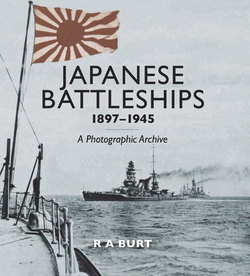Читать книгу Japanese Battleships, 1897?1945 - R. A. Burt - Страница 12
ОглавлениеDisplacement: 15,200 tons normal load
Dimensions: Length: 425ft oa; Beam: 75ft; Draught: 27ft 2in mean
Armament: 4 × 12in 40cal; 14 × 6in; 20 × 3in; TT: 4 × 18in
Armour: Main belt: 9in (Harvey); Barbettes: 14in–10in; Turrets: 10in–6in; Decks: 3in; Conning tower: 14in
Machinery: Two sets vertical triple-expansion engines driving two screws, twenty-five Belleville boilers
Designed SHP: 14,500 for 18 knots
Fuel: 700 tons coal normal, 1,400 tons max
Complement: 743
Laid down: July 1897, John Brown, Clydebank
Launched: 13 March 1899
Completed: July 1900
Fate: Torpedoed and sunk by USS Salmon 25 May 1942
Asahi 1900
Asahi anchored off Portsmouth during the summer of 1900. Ordered as a further unit of the post-war fleet, Asahi was the heaviest battleship built on the Clyde (John Brown) to that date. She was practically identical to the British HMS Formidable in appearance, but there were many technical differences: new-pattern 12in guns; shallow 9in armour belt with 6in above this, both belts being Harvey (HMS Formidable had a deep 9in Krupp belt); there were other armour differences. The ships had five boilers more than HMS Formidable (although both had approximately the same speed), and Asahi was a heavier coal consumer than her British contemporaries.
Asahi aground off Southsea 1900
Basically the same design as Shikishima, but with small modifications. On leaving for Japan in the summer of 1900, Asahi sailed past Southsea beach on her way out and ran fast aground, as shown here with a local Itchen ferry in the foreground. After stores and some ammunition had been removed she was pulled off and, after a thorough inspection of her hull, went on her way. Like many of the pre-dreadnoughts, she was disarmed after the First World War and used for training purposes.
Asahi as a coastal defence battleship 1920
This photograph shows her c1920 when she was relegated as a coastal defence battleship and before being disarmed and converted to general training ship etc. as part of the Washington Naval Treaty of 1921–22 (see also the previous caption). She was in constant use during the First World War as a gunnery training ship but saw no action during those years. Note that she still carries her anti-torpedo booms and is still using the Trotman anchor beds. (Most of the British pre-dreadnoughts had been fitted with stockless types during the First World War.)
Asahi off Portsmouth Harbour 1900
Whilst serving as a frontline unit she was engaged in the battle of Port Arthur in February 1904 then again in April 1904 against the Russian Battle Fleet. In action again at the battle of the Yellow Sea on 10 April 1904, she was hit by a 12in shell. In October of that year she ran across a mine and was badly damaged. Under repair until the spring of 1905, she was back in service in time to take part in the battle of Tsushima on 27 May 1905. Asahi was heavily engaged by Russian battleships and was hit six times but sustained only minimal damage. At the end of the First World War she was classed as obsolete, but later during 1922–23 was refitted as a training ship and used in this role for many years. She was still in use as training ship/repair and depot ship during the Second World War but was finally torpedoed on 25 May 1942 by USS Salmon (two hits) and sank slowly. She is shown here outside Portsmouth Harbour shortly after completion in the autumn of 1900.
